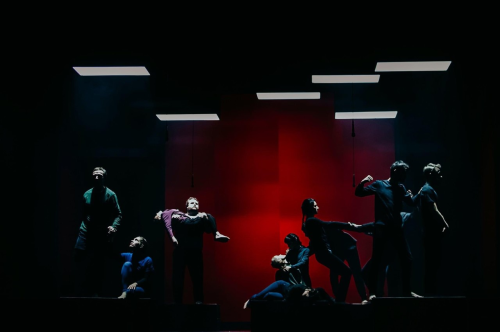
A blog of the Kennan Institute
Much to their dismay, director Dmytro Kostiumynskyi and his team with the DollMen Theater Company could not have been more prescient when they formulated their Ukrainian Odyssey. The project takes their creative team on a five-city tour (Kyiv-Lviv-Kharkiv-Odesa-Kyiv) to offer a contemporary take on Homer’s Odyssey and James Joyce’s Ulysses. They hoped to encourage audiences to travel and to see segments performed by different artists in other cities. But their parade of performances across Ukraine’s major cities had made only three stops before the destruction of a real war brought the tour to a precipitous stop.
Despite COVID restrictions, the DollMen theater group managed to bring its Ukrainian Odyssey project to its third stop at Kharkiv’s NEFT puppet theater prior to the Russian invasion. The immersive performance showed contemporary Ulysseses and Penelopes seeking their own paths though the chaos of a postapocalyptic virtual city.
Just weeks later, what had been virtual and theoretical became immediate and tangible. Kharkiv was at the center of a major battle which eventually turned back the Russian invaders, leaving lots of destruction and apocalyptic obstacles behind. By posing the imagined travails of life in a virtual city following urban collapse, DollMen’s theatrical performance helped prepare its audiences for the actual horrors of urban warfare to follow.

The Project started in 2020, inspired by the ongoing war in Eastern Ukraine that began in 2014. When Russian troops invaded the remainder of Ukraine on February 24, 2022, it took on new meaning. This work considers war, evolution, and heroism through five episodes in postapocalyptic cities created by several artistic teams performing dramatic and physical theater, virtual reality, and puppetry. It poses questions like: what does it mean to be a hero, an immigrant, a resident, a feminist, a nationalist, a patriot, a civilian, or a soldier, in a country that has survived horrific violence? What does the right to a city mean in such conditions?
Kostiumynskyi has created one of Ukraine’s most experimental theater groups with the c production company, which embraces different formats, new media, and cross-genre collaboration. After meeting Viktor Ruban, the Ukrainian choreographer and founder of Ruban Production ITP, Kostiumynsky initiated an exchange of artistic approaches. Ruban joined in to become an advocate for physical theater, storytelling in a space between mime and dance.
Kostiumynskyi formed DollMen in 2014 and immediately established connections with like-minded European theater directors. His production that year, Hamlet Babylone, combined contemporary music, video scenography, and interactive modern media to show Shakespeare’s Danish prince constructing and destroying a personal world in an unstable virtual environment. The work played in Geneva, where it won encouraging reviews.
Kostiumynskyi and the company turned to Ukrainian matters with the stunning 2021 production Crimea, 5 am, dedicated to political prisoners, telling the story of human rights violations in Russian-occupied Crimea. Kostyiumynskyi feared that the human tragedy of the prisoners—who often are seized in their homes at 5 a.m.—and their families were becoming abstractions. He asked playwrights Natalya Vorozhbyt and Anastasia Kosodiy to write scripts based on interviews with real activists to create a documentary text. The production and accompanying videos and books brought the human dimension of incarceration back to the center of Ukrainian attention.
Ruban is a performing artist, choreographer-researcher, dancer, producer, curator, and educator who, among numerous projects, has served as artistic director of the #KyivDanceResidency. Ruban has worked with dance and performance centers across Europe and North America to use dance to expand the integration of the arts through community engagement as well as to promote understanding of how choreography can be used. For the Ukrainian Odyssey, Ruban and Kostiuminskyi are working with the Lviv Academic Dramatic Lesia Theater. This collaboration brings physical theater into the project.
Ukrainian Odyssey has hit the pause button, as most of the company members have headed off to war. Recreational travel around Ukraine has come to a halt. But the project’s creators continue to redefine the project in light of all that is happening. Despite the war, Lesia Theater in Lviv re-premiered the piece in June, adding accents prompted by events since February 24. With Kostiumynskyi off on the front lines, the theater team, together with Ruban, connected with him online to create the new premiere. The re-premier demonstrated how art can sometimes foretell events and sometimes help us prepare for them.
Bringing Homer's Odyssey to the stage in contemporary Ukraine has proven an Odyssey in itself. As choreographer Ruban notes:
The actors of theater observed that this work helped them getting back to work. It’s not evident but in Ukraine actors are experiencing very hard times because it’s mentally challenging to perform anything light and inspiring when the war is around; but even more emotionally challenging is to perform on a war subject. The physical theater approach animating this piece became a great help to actors. This approach gives the possibility to address emotions arising in the action into physical tasks of scene and, through them, to cope at the same time as becoming aware. This consciousness enables them to address more effectively the text performed as spoken word.
I had a chance to speak with audience after the June 2022 performance and they couldn’t believe that we premiered this piece in 2020. It has several parts that are like ‘tableau vivant’ in which only today we can recognize images from Bucha, Irpin, Mariupol and other places…
In this instance, the artistic imagination explored a future otherwise thought unimaginable.
The opinions expressed in this article are those solely of the author and do not reflect the views of the Kennan Institute.
Author

Former Wilson Center Vice President for Programs (2014-2017); Director of the Comparative Urban Studies Program/Urban Sustainability Laboratory (1992-2017); Director of the Kennan Institute for Advanced Russian Studies (1989-2012) and Director of the Program on Global Sustainability and Resilience (2012-2014)

Kennan Institute
After more than 50 years as a vital part of the Wilson Center legacy, the Kennan Institute has become an independent think tank. You can find the current website for the Kennan Institute at kennaninstitute.org. Please look for future announcements about partnership activities between the Wilson Center and the Kennan Institute at Wilson Center Press Room. The Kennan Institute is the premier US center for advanced research on Eurasia and the oldest and largest regional program at the Woodrow Wilson International Center for Scholars. The Kennan Institute is committed to improving American understanding of Russia, Ukraine, Central Asia, the South Caucasus, and the surrounding region through research and exchange. Read more

Explore More in Focus Ukraine
Browse Focus Ukraine
Talking to the Dead to Heal the Living

Ukrainian Issue in Polish Elections


